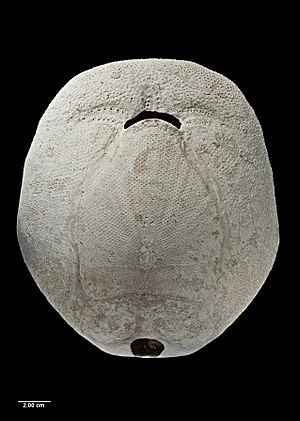Giant heart urchin facts for kids
Quick facts for kids Brissus gigas |
|
|---|---|
 |
|
| Scientific classification | |
| Kingdom: | |
| Phylum: | |
| Class: | |
| Order: |
Spatangoida
|
| Family: |
Brissidae
|
| Genus: |
Brissus
|
| Species: |
B. gigas
|
| Binomial name | |
| Brissus gigas (H.B. Fell, 1947)
|
|
Brissus gigas, also known as the Giant heart urchin, is a special type of sea urchin. It belongs to the Brissidae family. These sea urchins have a hard shell covered with many spines. Scientists first described Brissus gigas in 1947.
What Does the Giant Heart Urchin Look Like?
The Giant heart urchin, Brissus gigas, can grow quite large. Most of these sea urchins are between 50 and 190 millimeters long. That's about 2 to 7.5 inches! The biggest one ever found was even larger. It was collected near Great Mercury Island in 2009 and measured 193 millimeters. This is almost 8 inches long, making it a truly giant sea urchin.
Where Do Giant Heart Urchins Live?
You can find Brissus gigas around the north and north-east coasts of the North Island in New Zealand. They live in areas from the Manawatāwhi / Three Kings Islands all the way down to Great Mercury Island.
These sea urchins like to live in burrows. They dig into sandy or muddy areas close to the coast. They are found in the sublittoral zone, which is the part of the ocean floor that is always covered by water, even at low tide.
In 1982 and 1983, a natural event affected many Brissus gigas in the Hauraki Gulf. Tiny ocean plants, called Cerataulina pelagica, grew very quickly. This caused the water to lose a lot of its oxygen, which made it hard for the sea urchins to survive.

